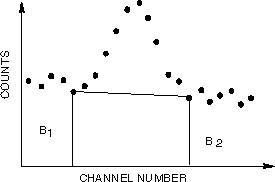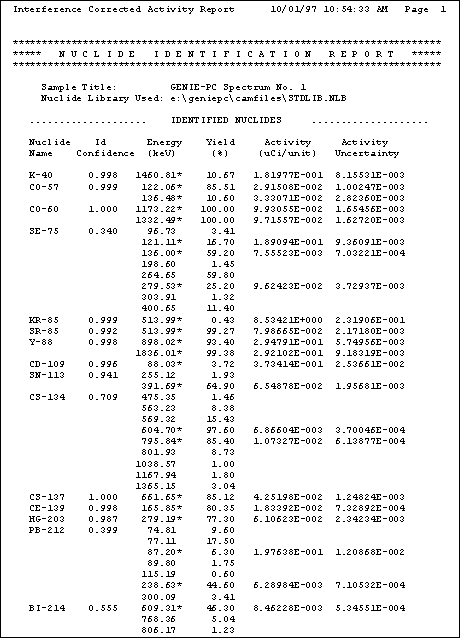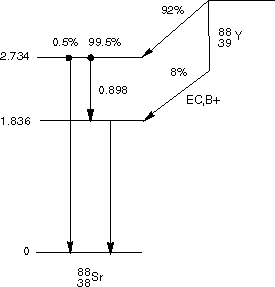Literature >
Basic Principles >
Spectrum Analysis -
Introduction
Canberra offers a variety of nuclear systems which perform data
analysis as well as data acquisition. These systems range from small
stand alone systems to more sophisticated configurations involving a
variety of computer platforms. Typical applications include
Environmental Monitoring, Body Burden Analysis, Nuclear Waste Assay,
Safeguards and other applications. The following section presents
some of the typical procedures and calculations involved in nuclear
applications.
Counting Statistics
Radioactive decay occurs randomly in time, so the measurement of
the number of events detected in a given time period is never exact,
but represents an average value with some uncertainty. Better
average values can be obtained by acquiring data over longer time
periods. But, since this is not always possible, it is necessary to
be able to estimate the accuracy of any given average.
Nuclear events follow a Poisson distribution which is the
limiting case of a binomial distribution for an infinite number of
time intervals, and closely resembles a Gaussian distribution when
the number of observed events is large. The Poisson distribution for
observing N events when the average is N, is given by:

and has standard deviation s (sigma)
equal to  . A graph of PN for
. A graph of PN for  equal to 3 and to 10 is shown in Figure 1.50. The
curves are asymmetric and have the property that
equal to 3 and to 10 is shown in Figure 1.50. The
curves are asymmetric and have the property that  is not exactly the most probable value but is close
to it. However, as N increases the curve becomes more symmetric, and
approaches the Gaussian distribution:
is not exactly the most probable value but is close
to it. However, as N increases the curve becomes more symmetric, and
approaches the Gaussian distribution:

The integral of the area under the Gaussian curve is often used
to report errors in terms of a confidence level in percent. For
example, in the value reported as 64 ± 8, 8 is equal to s and represents 68% of the area under the
appropriate Gaussian curve for N=64. It may be stated as the value
one is 68% confident of obtaining if the measurement is repeated.
Traditionally, many of Canberra’s MCAs have used 1.65 s, which corresponds to a 90% confidence level.
Probable error is often used, which corresponds to a 50% confidence
level. These can be user-set to other values, such as:
| Value of
s |
%
Confidence |
| 0.68 |
50.0 |
| 1.00 |
68.3 |
| 1.15 |
75.0 |
| 1.65 |
90.0 |
| 1.96 |
95.0 |
Since the uncertainty depends upon the square root of the counts,
improvements in accuracy by counting longer, or by using a more
efficient detector, only increase as the square root. For example,
if 564 counts are obtained in an hour for s
=  » 24 for a 24/564 = 4.3%
accuracy, counting for two hours to get 1133 counts with s » 34 only gives an
improvement to 3.0%. In other words, counting twice as long gives an
improvement of 1/
» 24 for a 24/564 = 4.3%
accuracy, counting for two hours to get 1133 counts with s » 34 only gives an
improvement to 3.0%. In other words, counting twice as long gives an
improvement of 1/  = 0.71, or 29%.
= 0.71, or 29%.
Examples of data in which counting statistics apply include: the
counts in a counter, the counts in a single channel of an MCA
spectrum, or the sum of counts in a group of channels in an MCA
spectrum. The situation becomes even more complicated when
subtracting a background as shown in the following separate, but
frequent, cases.
- Subtracting background counts, as in one counter’s value from
another, or for each channel (when subtracting one spectrum from
another).
- Subtracting a straight line background from a peak on top of
the background in a spectrum, such as a HPGe peak on top of
Compton pulses from higher energy gamma rays.
The error in adding or subtracting two numbers with errors, as
in:

is given by:

Consider a low level counting situation in which 56 counts are
obtained in 10 minutes, and a background of 38 counts in 10 minutes
was measured without the sample. The result is 56-38 = 18 counts,
with an error of  =
=  or approximately 9.7, a s value
of 54%.
or approximately 9.7, a s value
of 54%.
A better procedure is to measure the background over a longer
period of time to obtain a small percentage error and factor to the
appropriate time for each sample analyzed. Using the same example as
above, but with a 100 minute background of 380 counts, the result
would be 56-(380/10) = 18 counts, with an error of

or approximately 7.7, a s value of
43%.
Net Area Calculation
For the case in which a peak lies on a background that cannot be
subtracted by a background spectrum, such as shown in Figure 1.51
for an MCA spectrum from a HPGe detector:

Figure 1.51
Net
Area Determination
The area above the background represents the total counts between
the vertical lines minus the trapezoidal area below the straight
line. If the total counts are P and the end-points of the straight
line are B1 and B2, then the net area is given
by:

Where n = The number of channels between B1 and
B2.
It is tempting to calculate the uncertainty by just using the
formula for subtracting two numbers, with standard deviations
of:

However, this is incorrect because the error in the trapezoidal
area is not just square root of the counts, but depends upon how the
errors in B1 and B2 affect the straight line
across the entire region. The proper procedure, which is implemented
in Canberra MCAs and in analysis of peak areas in various HPGe
software packages, is derived as follows:
The standard deviation in a function A is given by:
A = f(N1
N2 ...Nn)
where Nn is the counts in channel N.
The estimate of the standard deviation in A is given by:

Where P1...Pn are the channels in the peak
(inside B1 and B2).
End-Point Averaging
If the background is large compared to the peak area, a better
determination of background can be made by averaging over several
channels. If B1 is the sum of counts over n1
channels, and B2 over n2 channels, the area is
then:

and the standard deviation is:

Most Canberra MCAs and analysis software packages perform
end-point averaging with a user-selectable number of end-points.
There are many ways of calculating the net counts under a peak.
The method described above is a valid, common method, provided that
there are no interferences from photopeaks adjacent to the peak of
interest, and assuming that the background continuum varies linearly
from one side of the peak to the other.
However, if interferences exist, other methods of calculating the
net area of a peak must be employed which can include, (but are not
limited to), the use of parabolic or step background algorithms, as
well as non-linear fitting algorithms, etc. For further discussions
concerning these techniques and others, the reader is referred to
more detailed texts and formal spectroscopy training courses.
Energy Calibration
Many nuclear applications require a means for determining the
energy at a particular channel location of a spectrum. To meet this
need, Canberra has implemented various techniques which are briefly
discussed below.
In some MCAs, a simple two-point energy calibration is used to
determine both the offset and slope by the equation:
E = A(ch) + B
Where: ch = channel number
Thus, the energy vs. channel number can be directly read out.
However, the more advanced MCA Systems,
like the Genie 2000 and Genie-ESP Network allow users to choose
between first-order (i.e. linear) or second-order (i.e. quadratic)
equations that use a least squares fit to multiple data points.
Most preamplifier, amplifier and ADC systems are very linear and
first-order energy calibration can properly describe the data. For
example, a Canberra germanium detector with 2002 Preamplifier, 2025
Amplifier and 8701 ADC has nonlinearities less than 0.05% for the
preamplifier and amplifier, and 0.025% for the ADC. The combined
nonlinearity is then:

This is still a very small number, but for a spectrum of 4000
channels, the low and high energy channels may be correct and leave
a 0.00075 x 2000 = 1.5 channel uncertainty at channel 2000. A
second-order term in the energy calibration can remove this in order
to provide very accurate energy-channel calibration over the entire
range, according to the equation:
E = A(ch)2 +
B(ch) + C
Where: ch = channel number
A further refinement is provided by using least-squares
techniques to determine the equation that best fits the data, when
more than the minimum number of points is available, (2 for
first-order, 3 for second-order). The AccuSpec, Genie 2000 and
Genie-ESP MCA Systems use this technique.
Nuclide Identification and Quantitative Analysis
Many applications with high purity germanium (HPGe) detector
spectra involve identifying particular gamma rays with specific
nuclides. The sharp peaks in the HPGe spectra, coupled with a
careful precise energy calibration, can be used for generally unique
determinations of the nuclides in a sample. If an automatic peak
search capability is provided then a complete sample analysis can be
accomplished without operator intervention, which is ideal for
analyzing large numbers of samples. All Canberra HPGe/computer-based
gamma spectroscopy systems provide nuclide identification through
peak searches of spectra and scans of standard and user-generated
nuclide libraries. A sample printout of a Genie 2000 nuclide
identification report is shown in Figure 1.52.

Figure 1.52
Isotope ID
In the Genie 2000 and VMS-based platforms, the peak search
locates peak centroids and then enters a region of interest about
each peak. This is especially useful for observing the quality of
data obtained. Canberra analysis software provides the additional
capability of resolving overlapping peaks into individual
components.
The final step in nuclide analysis is to determine the intensity
of the radioactivity corresponding to each isotope. The net area of
the peak is directly related to the intensity, but it is also
necessary to correct for the efficiency of the detector, the
branching ratio of the source, and the half life (if it is desired
to relate the activity to an earlier or later time). The efficiency
was discussed earlier and has an energy dependence such as shown in
Figure 1.1. The branching ratio (or yield) is used to correct the
number of gamma rays observed to obtain the number of
disintegrations of the source. Figure 1.53 shows the decay scheme
for 88Y and the percent of disintegrations leading to the
various gamma rays.

Figure 1.53
88Y Decay Scheme
The activity of a particular isotope is given in microcuries
as:

Where yield is the branching ratio fraction and live time is the
actual ADC live time disintegrations per second. Half-life
corrections are made by multiplying an exponential factor.

Where decay time and half-life must be in the same units
(seconds, minutes, hours, or years).
Further specific data analysis is highly dependent upon the
application, detector and electronics configuration, and is beyond
the scope of this brief presentation.
Efficiency Calibration
In the equation for activity cited above, the value for
efficiency is dependent on the geometry of the sample - size,
density, and distance from detector. For the detectors used in gamma
analysis, efficiency varies significantly with energy (see Figure
1.1).
Therefore, each counting geometry requires an efficiency
calibration, using a known standard in the same geometry which
includes multiple energies. A series of data pairs of efficiency vs.
energy are generated from the relationship:

Where Activity is the strength (in Bq) of the standard source (at
collection time) at the given energy, yield is the branching ratio
fraction and live time is the actual ADC live time.
In the Genie software system, the calibration data from the
standard are entered into a "Certificate File", with these data
being used for subsequent efficiency calibrations. The software will
automatically correct for source decay by the formula:

Where decay time and half-life are in the same units (seconds,
minutes, hours, or years).
From the series of data pairs, a curve of efficiency versus
energy is generated, with the user having a choice of fitting
paradigms. Thus, the software can calculate efficiency at any energy
in the calibrated energy range when analyzing an unknown
spectrum.
Minimal Detectable Activity
The calculation of Minimum Detectable Activity for a given
nuclide, at the 95% confidence level, is usually based on Currie’s
derivation (Currie, L.A. (1968) Anal. Chem. 40:586.), with
one simplified formulation being:

where:
- s is the standard deviation of
the background at the energy of interest
- T is the collect time (sec)
- EFF is the efficiency at the energy of interest
- Y is the Branching Ratio wt is sample weight
This formulation takes into account both kinds of errors - false
positive and false negative, and yields the smallest level of
activity which can be detected with 95% confidence, while also
having 95% confidence that "activity" is not detected falsely from a
null sample. When the measurement is made on a ‘blank’, with no
activity, but with the same form and density as an actual sample,
the calculated MDA is an a priori estimate of the best
sensitivity that can be expected from sample measurements. When the
calculation is applied to a spectrum collected from an actual
sample, the background at the energy of interest will in most cases
be higher, due to interference and Compton scattering from other
nuclides in the sample. Thus, the MDA for an actual sample, computed
a posteriori, will be somewhat higher than the a
priori estimate.
The MDA - also referred to as Lower Limit of Detection (LLD) -
can be improved by increasing the efficiency of detection,
decreasing the background, or, for a given experimental setup, by
increasing the collect time. It is frequently necessary to select
the appropriate collect time to ensure that the measured MDA will be
below the action level mandated by the count-room procedures.
The above formula for MDA, generally accepted in the United
States and many other countries, is implemented in a more complete
form in Canberra Analytical software. Some Canberra software
packages, such as Genie 2000, offer the user a choice of additional
formulas required in other countries.
